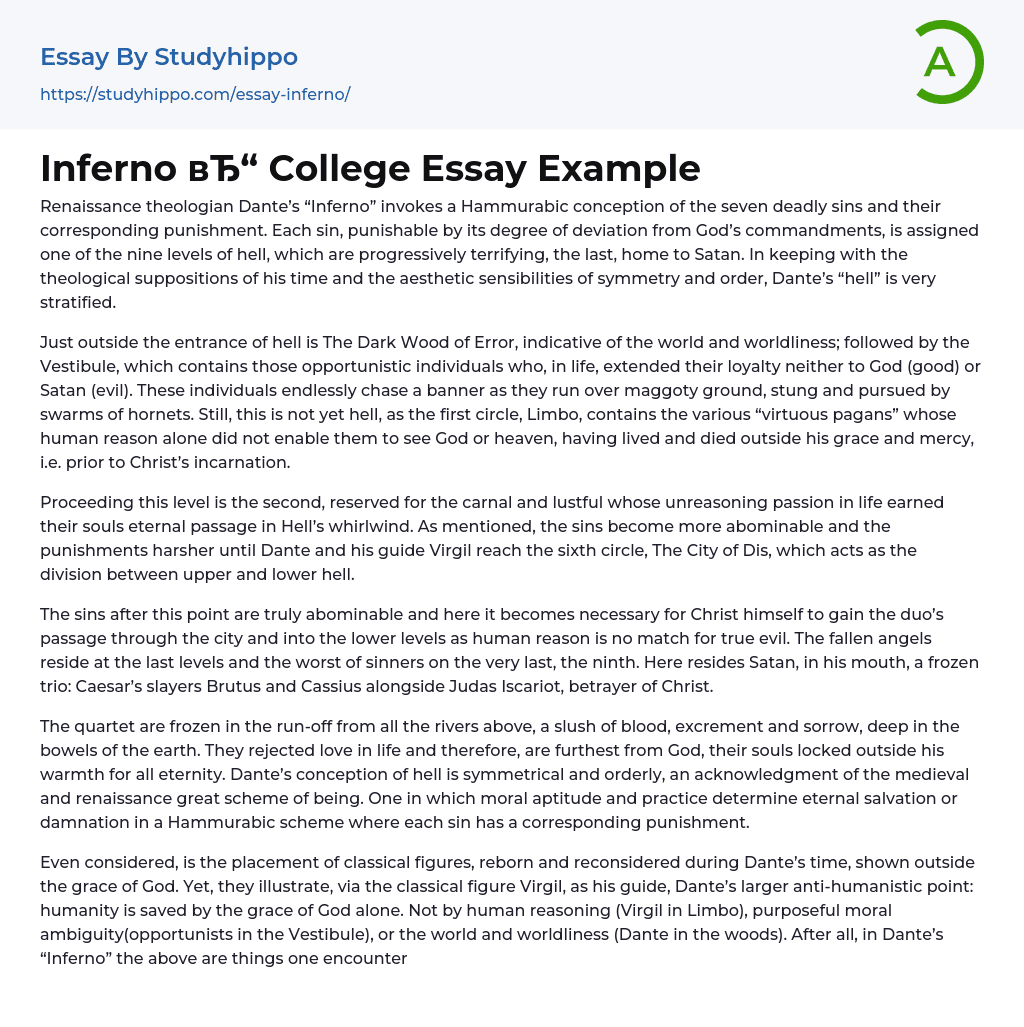In his work "Inferno," Dante, a Renaissance theologian, incorporates the concept of the seven deadly sins and their corresponding punishments from Hammurabi. The severity of each sin determines its sentencing to one of the nine levels of hell, which gradually escalate in horror until reaching Satan's dwelling place. Dante's portrayal of "hell" adheres to both theological beliefs and aesthetic principles such as symmetry and order, leading to a meticulously organized hierarchy.
The Dark Wood of Error, located just outside the entrance of hell, represents the world and worldliness. Immediately following is the Vestibule, where individuals who showed no loyalty to either God (good) or Satan (evil) during their lives are found. These individuals constantly chase after a banner as they move across a ground infested with maggots, while being stung
...and pursued by swarms of hornets. However, this is not yet considered hell. The first circle, known as Limbo, houses various "virtuous pagans" who, despite possessing human reason, were unable to recognize God or heaven. They lived and died without experiencing his grace and mercy, which occurred prior to Christ's incarnation.
In continuation of the previous level, the second level is for those who were carnal and lustful in life. As a result, their souls are damned to Hell's whirlwind forever. The sins committed become more detestable and the punishments harsher as they progress further. Dante and Virgil reach the sixth circle, called The City of Dis, which separates upper and lower hell.
The sins after this point are truly abominable. It becomes necessary for Christ himself to gain the duo’s passage through the city and into the lower
levels. Human reason is no match for true evil. The fallen angels reside at the last levels, and the worst of sinners reside on the very last level, the ninth. Satan resides here, with a frozen trio in his mouth: Caesar’s slayers Brutus and Cassius, alongside Judas Iscariot, betrayer of Christ.
The four individuals are trapped in the mixture of blood, excrement, and sadness that flows from the rivers above. They had disregarded love during their earthly existence, resulting in their souls being condemned to eternal separation from God's warmth. Dante's interpretation of hell is a reflection of the structured and balanced view of the world prevalent during the Middle Ages and the Renaissance. It follows a moral framework where one's actions and behavior determine their eternal fate, much like the Hammurabic code where each sin matches a specific punishment.
The placement of classical figures, which were reborn and reconsidered during Dante’s time, is also considered. These figures are depicted as being outside the grace of God. However, they serve to illustrate Dante’s larger anti-humanistic point, with the help of the classical figure Virgil who serves as his guide. The point being that humanity can only be saved by the grace of God alone. This salvation cannot be achieved through human reasoning (as seen in Virgil’s situation in Limbo), purposeful moral ambiguity (as seen in the opportunists in the Vestibule), or by worldly matters and worldliness (as experienced by Dante in the woods). Ultimately, all of these elements are encountered on the journey to hell in Dante’s “Inferno”.
- Baptism essays
- Holy Spirit essays
- Jesus Christ essays
- Adam And Eve essays
- Crucifixion Of Jesus essays
- Crusades essays
- Eucharist essays
- God The Father essays
- Pope essays
- Protestantism essays
- Christian essays
- Church essays
- Elizabeth essays
- Sacrament essays
- Catholic Church essays
- Lord essays
- Priest essays
- Protestant Reformation essays
- Professor essays
- Should College be Free essays
- Should college athletes be paid essays
- College Education essays
- College Tuition essays
- Graduation essays
- College Goals essays
- Personal Statement essays
- Online Classes Vs Traditional Classes essays
- Online Education essays
- Student Loan essays
- Study Abroad Scholarship essays
- Reasons To Go To College essays
- Paying College Athletes essays
- Technology In The Classroom essays
- Spirituality essays
- Angel essays
- Afterlife essays
- Atheism essays
- Bible essays
- Buddhism essays
- Christian Worldview essays
- Christianity essays
- Confession essays
- Cosmological Argument essays
- Deism essays
- Devil essays
- Existence of God essays
- Faith essays
- Freedom Of Religion essays
- God essays
- Hinduism essays




